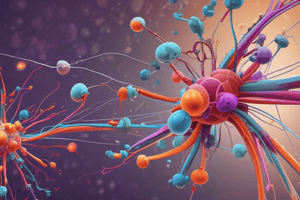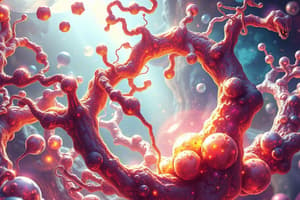Podcast
Questions and Answers
what are enzymes?
what are enzymes?
Proteins that act as catalysts for biochemical reactions
what are the properties of enzymes?
what are the properties of enzymes?
not consumed during the reaction most effective catalysts Most enzymes are globular proteins
what is the the delta G of a spontaneous reaction?
what is the the delta G of a spontaneous reaction?
delta G of product is less that delta G of substrate
what does the rate of reaction depend on?
what does the rate of reaction depend on?
what is the transition state?
what is the transition state?
what is the delta G or energy of activation?
what is the delta G or energy of activation?
the higher the delta G?
the higher the delta G?
how does an enzyme lower the energy of activation?
how does an enzyme lower the energy of activation?
what are simple enzymes?
what are simple enzymes?
what is a conjugated enzyme?
what is a conjugated enzyme?
what is an apoenzyme
what is an apoenzyme
what is a cofactor?
what is a cofactor?
what is a holoenzyme?
what is a holoenzyme?
what are prosthetic groups, cofactors and coenzymes?
what are prosthetic groups, cofactors and coenzymes?
what are the properties of cofactors?
what are the properties of cofactors?
what are the properties of coenzymes?
what are the properties of coenzymes?
what are some common coenzymes and what do they do?
what are some common coenzymes and what do they do?
what forms the complete enzyme?
what forms the complete enzyme?
what are the properties of the apoenzyme?
what are the properties of the apoenzyme?
how are enzymes named?
how are enzymes named?
what is the suffix that identifies a substance as an enzyme?
what is the suffix that identifies a substance as an enzyme?
what is often used as a prefix when naming enzymes?
what is often used as a prefix when naming enzymes?
what else is used when naming an enzyme in addition to type of reaction?
what else is used when naming an enzyme in addition to type of reaction?
how are enzymes classed?
how are enzymes classed?
what are the classes of enzymes?
what are the classes of enzymes?
what do oxidoreductases require?
what do oxidoreductases require?
what are the subtypes of transferases?
what are the subtypes of transferases?
what does hydrolase do? and what process is it crucial for?
what does hydrolase do? and what process is it crucial for?
what is a lyase?
what is a lyase?
what are the classes of lyases?
what are the classes of lyases?
what is an isomerase?
what is an isomerase?
what is a ligase?
what is a ligase?
why is atp required in ligase reactions?
why is atp required in ligase reactions?
what is the active site? how is it formed?
what is the active site? how is it formed?
what is the lock and key model?
what is the lock and key model?
what are the limitations and reality of the lock and key model?
what are the limitations and reality of the lock and key model?
what is the induced fit model?
what is the induced fit model?
what are the properties of induced fit model?
what are the properties of induced fit model?
what are the forces that assist substrate binding?
what are the forces that assist substrate binding?
what are the 4 types of enzyme specificity?
what are the 4 types of enzyme specificity?
what is absolute specificity?
what is absolute specificity?
what is group specificity?
what is group specificity?
what is linkage specificity?
what is linkage specificity?
what is stereochemical specificity?
what is stereochemical specificity?
what are the 4 mechanisms of enzyme catalysis?
what are the 4 mechanisms of enzyme catalysis?
what is catalysis by proximity?
what is catalysis by proximity?
what is acid-base catalysis?
what is acid-base catalysis?
what is catalysis by strain?
what is catalysis by strain?
what is covalent catalysis?
what is covalent catalysis?
what are the types of AA that should be found in the active site of enzymes for covalent catalysis to take place?
what are the types of AA that should be found in the active site of enzymes for covalent catalysis to take place?
what mechanism of enzyme catalysis follows a ping pong mechanism?
what mechanism of enzyme catalysis follows a ping pong mechanism?
what are the factors affecting enzyme activity?
what are the factors affecting enzyme activity?
what is enzyme activity?
what is enzyme activity?
how does higher temperature affect enzyme activity?
how does higher temperature affect enzyme activity?
what is optimum temperature?
what is optimum temperature?
how does ph affect enzyme activity?
how does ph affect enzyme activity?
what is optimum ph?
what is optimum ph?
what is the optimum ph of pepsin and trypsin?
what is the optimum ph of pepsin and trypsin?
how does substrate concentration affect enzyme activity?
how does substrate concentration affect enzyme activity?
what is the limit of substrate saturation?
what is the limit of substrate saturation?
what is turnover number?
what is turnover number?
how does enzyme concentration affect enzyme activity?
how does enzyme concentration affect enzyme activity?
what are the things that come under enzyme kinetics?
what are the things that come under enzyme kinetics?
what is a zero order reaction?
what is a zero order reaction?
what is a first order reaction?
what is a first order reaction?
in the michaelis-menten curve, very low substrate concentration indicates which order?
in the michaelis-menten curve, very low substrate concentration indicates which order?
when the substrate conc increases this means?
when the substrate conc increases this means?
when the substrate conc is very high this indicates?
when the substrate conc is very high this indicates?
what is mixed order?
what is mixed order?
what is vmax?
what is vmax?
what is vmax1/2?
what is vmax1/2?
what is km?
what is km?
what does michaelis constant represent?
what does michaelis constant represent?
low km means?
low km means?
high km means?
high km means?
what is the formula for the michaelis-menten curve?
what is the formula for the michaelis-menten curve?
what is the formula for the Lineweaver-Burk plot?
what is the formula for the Lineweaver-Burk plot?
what is an enzyme inhibitor?
what is an enzyme inhibitor?
what is a competitive inhibitor?
what is a competitive inhibitor?
what is a noncompetitive inhibitor?
what is a noncompetitive inhibitor?
what is reversible competitive inhibition?
what is reversible competitive inhibition?
what is reversible noncompetitive inhibition?
what is reversible noncompetitive inhibition?
how does increasing concentration of substrate effect inhibition in reversible noncompetitive inhibition?
how does increasing concentration of substrate effect inhibition in reversible noncompetitive inhibition?
how does increasing concentration of substrate effect inhibition in reversible competitive inhibition?
how does increasing concentration of substrate effect inhibition in reversible competitive inhibition?
what are examples of reversible noncompetitive inhibitors?
what are examples of reversible noncompetitive inhibitors?
what is a reversible uncompetitive inhibitor?
what is a reversible uncompetitive inhibitor?
give the summary of lineweaver-burke plots in inhibitors
give the summary of lineweaver-burke plots in inhibitors
what is irreversible enzyme inhibition?
what is irreversible enzyme inhibition?
how does substrate concentration affect inhibition in irreversible inhibition?
how does substrate concentration affect inhibition in irreversible inhibition?
what are the properties of allosteric enzymes?
what are the properties of allosteric enzymes?
what happens when molecules bind at the regulatory site of allosteric enzymes?
what happens when molecules bind at the regulatory site of allosteric enzymes?
what happens with the binding of a positive and negative regulator?
what happens with the binding of a positive and negative regulator?
what are regulators of allosteric enzymes? (feedback control)
what are regulators of allosteric enzymes? (feedback control)
what is a proteolytic enzyme?
what is a proteolytic enzyme?
what are zymogens?
what are zymogens?
how to turn a zymogen (proenzyme) into a proteolytic enzyme (active enzyme)
how to turn a zymogen (proenzyme) into a proteolytic enzyme (active enzyme)
what is covalent modification?
what is covalent modification?
what is an example of a common covalent modification?
what is an example of a common covalent modification?
During phosphorylation/dephosphorylation, what amino acids are the phosphate groups added to/removed from?
During phosphorylation/dephosphorylation, what amino acids are the phosphate groups added to/removed from?
what are extremozymes?
what are extremozymes?
what are: 1. acidophiles, 2. alkaliphiles, 3. halophiles, 4. hyperthermophiles, 5. piezophiles
what are: 1. acidophiles, 2. alkaliphiles, 3. halophiles, 4. hyperthermophiles, 5. piezophiles
what are the steps for gathering commercially successful enzymes?
what are the steps for gathering commercially successful enzymes?
what are the applications of extremozymes?
what are the applications of extremozymes?
what are the enzymes lactate dehydrogenase (LDH) and creatine kinase (CK) used for in medical diagnostics?
what are the enzymes lactate dehydrogenase (LDH) and creatine kinase (CK) used for in medical diagnostics?
what are the enzymes, pancreatic amylase and pancreatic lipase, used for in medical diagnostics?
what are the enzymes, pancreatic amylase and pancreatic lipase, used for in medical diagnostics?
what are the enzymes urokinase and streptokinase used for in medical therapeutics?
what are the enzymes urokinase and streptokinase used for in medical therapeutics?
what are examples of prescription drugs that work by inhibiting enzymes?
what are examples of prescription drugs that work by inhibiting enzymes?
what is angiotensin and how do ACE inhibitors work?
what is angiotensin and how do ACE inhibitors work?
what AA are removed in turning angiotensinogen to angiotensin?
what AA are removed in turning angiotensinogen to angiotensin?
what are sulfa drugs?
what are sulfa drugs?
what is sulfanilamide? how is it antibiotic?
what is sulfanilamide? how is it antibiotic?
how does penicillin inhibit transpeptidase?
how does penicillin inhibit transpeptidase?
how are enzymes used in research?
how are enzymes used in research?
Flashcards
Capital of France (example flashcard)
Capital of France (example flashcard)
Paris



